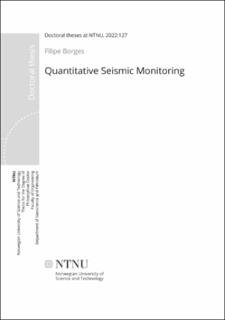| dc.description.abstract | Seismic data is the main input for reservoir characterization in developing plays, when - in general - only conceptual geological models and few wells are available. When repeated over time, in a process called 4D seismic or time-lapse seismic, this type of geophysical measurement can become a powerful aid in reservoir monitoring and geomechanical risk assessment, since it is the only broad, spatiallycontinuous probing method for deep reservoir surveillance. The indirect nature of the seismic measurement, however, might make its interpretation ambiguous, particularly when we consider limitations caused by resolution, noise and inadequate acquisition geometry and processing. This uncertainty plays a more important role when time-lapse seismic measurements are used for quantitative estimations of changes in the reservoir or the overburden.
The main goal of this Ph.D. project was to develop and evaluate techniques for quantitative interpretation of time-lapse seismic data, as well as its associated uncertainties. In the first chapter of this thesis, we introduce some rock physics models, which are the essential link between seismic measurements and the subsurface properties. We discuss the seismic properties of brines, the most common fluid in subsurface, and how its salinity and temperature can affect the interpretation of 4D data. The same discussion is made for fluid mixing - another source of uncertainty in reservoir 4D seismic interpretation. The use of time-lapse anisotropy changes as source of information is also presented. These considerations are combined in various synthetic scenarios, which are used as examples to explore the uncertainties of quantitative interpretation of 4D seismic.
In the second chapter, the feasibility of near-well monitoring with tube waves is studied, and the analysis of several experiments with shallow well data acquisition is presented. The tube wave discussed here is the Stoneley mode, and its velo city and anelastic attenuation are connected to the shear modulus of the formation surrounding the well. Precise measurement of this wave mode can allow for monitoring the shear modulus of the nearby rock, and hence can be used as a time-lapse method. The acquisition and processing of data are detailed, and two modeled scenarios for monitoring are presented as feasibility studies.
The third chapter details a case study where time-lapse seismic is used for geomechanical monitoring in Ekofisk (southern North Sea). Due to a well collapse, water was injected into the overburden for over two years. The injection is thought to have caused a seismic event of moderate magnitude, together with sea bottom uplift. Seismic measurements, time-lapse bathymetry and forward geomechanical modeling are integrated to understand the effect of the water injection in the stress state of the field, which is also affected by the reservoir compaction caused by 4 decades of oil production.
The fourth chapter discusses the analysis of data recorded by the Valhall Life of Field Seismic (LoFS) system in 2014, during an ongoing acquisition in a nearby field. Several normal modes (harmonics) can be identified in the seismic data, despite the source-receiver offset being over 30 km. These harmonics can be used to monitor the shallow sediment layer, based on an analytical model. Low-frequency diving waves were also identified. A method to estimate the seafloor P-wave velocity based on passive measurements is suggested, evidencing how these unique acquisition geometries open the door for different monitoring methods.
The fifth and last chapter presents an analysis of the effects of water velocity variations and geometry repeatability in offshore seismic acquisitions. Elastic seismic modeling was performed, using high-resolution property models for two distinct survey dates. On each date, different water velocity profiles, measured in field experiments, are considered. To incorporate source and receiver non-repeatability, some differences in the acquisition geometries are also tested for each vintage. The synthetic data were compared in terms of time-lapse amplitudes, and repeatability was quantified via the normalized root mean squared attribute (NRMS). For the parameters considered in the study, the deterioration of NRMS seemed to be dominated by the non-repeatability of the receivers and by water velocity variations, with source non-repeatability having a lower contribution. The results can be used as a step towards a more robust methodology for time-lapse feasibility studies, which incorporates imaging uncertainties and allows us to understand the contribution of each element that could affect the 4D quality. | en_US |
